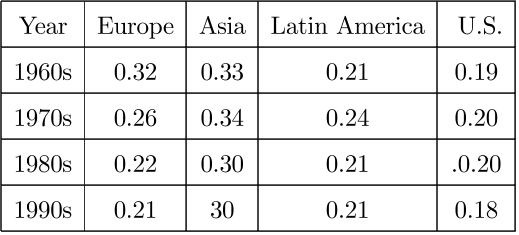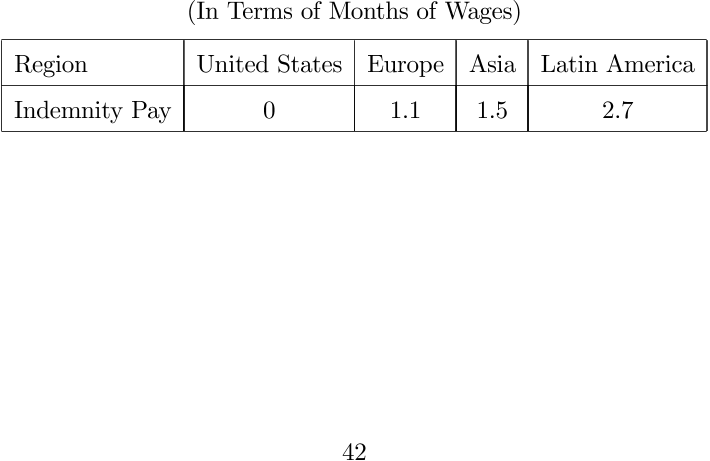Latin America in the rearview mirror
Harold L. Cole,Harold L. Cole,Lee E. Ohanian,Lee E. Ohanian,Lee E. Ohanian,Alvaro Riascos,James A. Schmitz +6 more
Reads0
Chats0
TLDR
This paper found that Latin American countries are the only Western countries that are poor and that are not gaining ground on the U.S. due to TFP differences, and that this failure is not plausibly accounted for by human capital differences, but rather reflects inefficient production.About:
This article is published in Journal of Monetary Economics.The article was published on 2005-01-01 and is currently open access. It has received 179 citations till now. The article focuses on the topics: Latin Americans & Total factor productivity.read more
Figures

Table 6. Investment-to-Output Ratios by Region (Regional Averages for Selected Countries) 
Table 4. Employment Rates by Region (Regional Averages for Selected Countries) 
Table 7. Bils-Klenow Relative Human Capital Levels (Regional Averages for Selected Countries, U.S. = 100) 
Table 5. Capital-to-Ouput Ratios by Decade Average Relative to the U.S.* 
Table 10. Government Ownership Share of the Top 10 Banks 
Table 11. Mandated Severance Pay
Citations
More filters
Posted Content
The Sources of Long-Term Economic Growth for Turkey, 1880-2005
TL;DR: In this article, the authors examined the sources of long-term economic growth for Turkey over the period 1880-2005 and provided a unique look at the growth experience of these two different political and economic regimes.
Journal ArticleDOI
Sources of long-term economic growth for Turkey, 1880–2005
TL;DR: In this article, the authors examined the sources of long-term economic growth for Turkey over the period 1880-2005 and provided a unique look at the growth experience of these two different political and economic regimes.
Journal ArticleDOI
Why We Shouldn't Turn Our Backs on Financial Globalization
TL;DR: In this paper, the authors argue that financial globalization can be a powerful force in promoting economic growth and the reduction of poverty in emerging market countries and that financial development enables the financial system to allocate capital to its most productive uses and is crucial to the success of an economy.
Journal ArticleDOI
Which sectors make poor countries so unproductive
TL;DR: This article developed a new framework for sectoral development accounting and applied this framework to the Penn World Table, finding that in equipment, construction, and food the sectoral TFP differences between developing countries and the United States are much larger than in the aggregate.
Posted Content
The Barrier Model of Productivity Growth : South Africa.
Torfinn Harding,Jørn Rattsø +1 more
TL;DR: In this paper, a country study of the barrier model exploiting the dramatic changes in the linkages to the world economy in South Africa is presented, where the productivity growth in the manufacturing sector panel for 1970-2003 covers a period of political and economic turbulence and international sanctions.
References
More filters
ReportDOI
Economic Growth in a Cross Section of Countries
TL;DR: For 98 countries in the period 1960-1985, the growth rate of real per capita GDP is positively related to initial human capital (proxied by 1960 school-enrollment rates) and negatively related to the initial (1960) level as mentioned in this paper.
Journal ArticleDOI
Why Do Some Countries Produce so Much More Output Per Worker than Others
TL;DR: This paper showed that differences in physical capital and educational attainment can only partially explain the variation in output per worker, and that a large amount of variation in the level of the Solow residual across countries is driven by differences in institutions and government policies.
Journal ArticleDOI
Why do Some Countries Produce So Much More Output Per Worker than Others
Robert E. Hall,Charles I. Jones +1 more
TL;DR: This article showed that the differences in capital accumulation, productivity, and therefore output per worker are driven by differences in institutions and government policies, which are referred to as social infrastructure and called social infrastructure as endogenous, determined historically by location and other factors captured by language.
Journal ArticleDOI
Technology, Geography, and Trade
Jonathan Eaton,Samuel Kortum +1 more
TL;DR: This article developed a Ricardian trade model that incorporates realistic geographic features into general equilibrium and delivered simple structural equations for bilateral trade with parameters relating to absolute advantage, comparative advantage, and geographic barriers.
Journal ArticleDOI
The Regulation of Entry
TL;DR: In this article, the authors present new data on the regulation of entry of start-up firms in 85 countries, covering the number of procedures, official time, and official cost that a startup must bear before it can operate legally.
Related Papers (5)
Why do Some Countries Produce So Much More Output Per Worker than Others
Robert E. Hall,Charles I. Jones +1 more